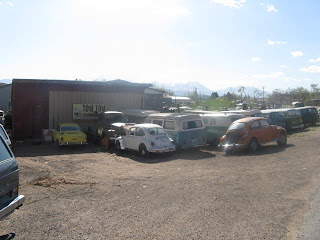Moab is one of those rare towns that lives up to its billing. You will never see a more impressive confluence of off-road Jeep enthusiasts, river rats, mountain bike freaks, hardcore backpackers, campground RVers, and plain old folks just wanting to get a good look at the rocks.
Moab Rick & Monette offered up a spot on their acreage for our little home-away-from-home on wheels. Not only did Rick let us paw through his incredible collection of rare expat literary journals from 1920s Paris (and serve up a night of honest-to-god home cookin’), he gave us an insider’s guide to the best watering holes in town, critical national park hiking destinations, and revealed the secret locations for free national park-side camping. “If one of the rangers hassles you, but since there’s only two of them chances are they won’t,” Moab Rick assured us, “just say: Russ in the office said it was okay to camp here.”
To which we say, Thanks Russ! And thanks Rick!
All of this homelife set us to thinking about the idea of home. Not so much what it means, but what it is and how it is expressed. This in mind, we sailed through the Navajo Nation of northern Arizona and New Mexico, past "Shiprock" (or Winged Rock), the spiritual center of the universe to the Navajo. Since we're not of the tribe, this is as close as we could get. But we could get right up and into the so-called Aztec ruins of the Anasazi people, a thousands year-old civilization that mysteriously and suddenly disappeared in the 1300s. Their homey little village, however ruined, remains.
But we could get right up and into the so-called Aztec ruins of the Anasazi people, a thousands year-old civilization that mysteriously and suddenly disappeared in the 1300s. Their homey little village, however ruined, remains. Which is all very instructive and interesting and worth pondering and all. But that was then. And in today's world, when the grime of the desert wears thick and the miles on the road weigh heavy you can step back in time and fall into the soft embrace of the modern world. Do this in Durango, CO and you'll find yourself at the Strater Hotel.
Which is all very instructive and interesting and worth pondering and all. But that was then. And in today's world, when the grime of the desert wears thick and the miles on the road weigh heavy you can step back in time and fall into the soft embrace of the modern world. Do this in Durango, CO and you'll find yourself at the Strater Hotel. Don't get us wrong. Living in a '71 microbus is great. But a night's stay at the Strater is a sweet reprise. In many ways it's better than home.
Don't get us wrong. Living in a '71 microbus is great. But a night's stay at the Strater is a sweet reprise. In many ways it's better than home. But then again, as fine a place as it may be, this hotel isn't home. So we pressed onward, heading east, stopping in Colorado Springs at a place that used to be home. Some of you may recognize it. Some of you have even lived there, too. You know who you are.
But then again, as fine a place as it may be, this hotel isn't home. So we pressed onward, heading east, stopping in Colorado Springs at a place that used to be home. Some of you may recognize it. Some of you have even lived there, too. You know who you are.

 It's been about 20 years since I left this place. Much of the complex has changed for the better, I hasten to add, and my old sport of cycling has moved elsewhere. While the old ghosts remain, only I can see them (though Diane, bless her soul, has had to hear all about them). And it's just as well. Because when we moved on down the road, our baggage happily remained curbside.
It's been about 20 years since I left this place. Much of the complex has changed for the better, I hasten to add, and my old sport of cycling has moved elsewhere. While the old ghosts remain, only I can see them (though Diane, bless her soul, has had to hear all about them). And it's just as well. Because when we moved on down the road, our baggage happily remained curbside.But where to next? Where on the road can you find your home? Turns out the answer lays not in the imagination. It was instead waiting for us a few miles up the road just outside of Greeley, CO. And it looks like this:
 And though this isn't the house I grew up in, it is my mother's home. Which is to say, we are finally home, too ... for now.
And though this isn't the house I grew up in, it is my mother's home. Which is to say, we are finally home, too ... for now.













































